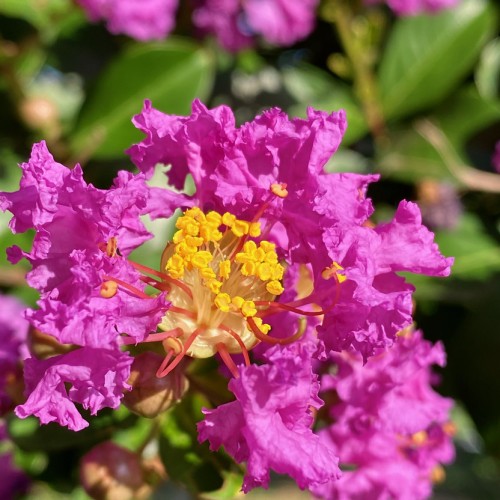
crape myrtle
Lagerstroemia indica 'Delta Blush'
Cycle:
Perennial
Watering:
Average
Hardiness Zone:
6 - 9
Flowers:
Flowers
Sun:
Full sun
Leaf:
Yes
Growth Rate:
Low
Maintenance:
Moderate
Salt Tolerant:
Yes
Care Level:
Medium
watering
Crape myrtle (Lagerstroemia indica 'Delta Blush') should be watered deeply and slowly about once a week, providing it with 1 inch of water per week. Soak the soil to a depth of 12-18 inches — allowing the water to soak in slowly. During hot weather, the plant may need to be watered more often. On the other hand, during the cooler weather, the plant should only be watered when the top inches of the soil feel dry. Make sure to not over-water the plant as it can stunt its growth.
sunlight
Crape Myrtle (Lagerstroemia indica 'Delta Blush') should be planted in an area that receives a minimum of 6-8 hours of direct sunlight every day. Full sunlight is preferred for the best growth and flowering. The Delta Blush variety also prefers to have slightly cooler temperatures, so providing partial shade during the hottest parts of the day (during summer in particular) may be beneficial, as long as it won't block more than 4 hours of direct sunlight.
pruning
Crape Myrtles should be pruned twice a year for optimum growth, health, and aesthetics. Early spring is the best time of year to prune Crape Myrtles, before new growth begins and buds have opened. This will help to prevent the “broom-like” habit that Crape Myrtles are known for, and will also increase their flowering potential. Pruning should be done again after the first bloom in late spring/early summer. Any branches that are dead, diseased, or damaged should be removed at any time of the year. Also, prune the old blooms off the branches to promote repeat flowering. In terms of how much to prune, Crape Myrtles should be pruned only to remove dead, diseased, or damaged wood, and to help with the overall shape of the tree. Before pruning, it is best to consult a qualified arborist or experienced gardener to help determine how much pruning is necessary for the particular specimen of Crape Myrtle.
